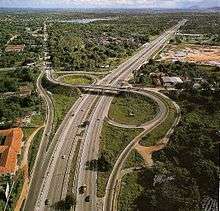BR-116
| |
|---|---|
 | |
| Route information | |
| Length | 2,864.65 mi[1] (4,610.21 km) |
| Existed |
1951 (Rio-São Paulo) 1948 (Rio-Fortaleza) 1967-1977 (divided highways of Rodovia Presidente Dutra and Rodovia Régis Bittencourt) – present |
| Major junctions | |
| North end | Fortaleza, Ceará |
|
CE-356 in Russas, CE BR-404 in Icó, CE BR-232 in Salgueiro, PE BR-324 in Feira de Santana, BA BA-262 in Vitória da Conquista, BA BR-259 in Governador Valadares, MG BR-495 in Teresópolis, RJ BR-101 in Rio de Janeiro, RJ BR-277 in Curitiba, PR BR-280 in Mafra, SC BR-282 in Lages, SC | |
| South end | Jaguarão, Rio Grande do Sul |
| Highway system | |
|
Highways in Brazil | |
BR-116 is a federal highway of Brazil.[2] One of the most important highways in Brazil and the second longest, its 4,385 kilometres (2,725 mi) connect Fortaleza, Ceará, one of the largest Northeast Brazil metropolises, to the southern city of Jaguarão, Rio Grande do Sul, in the border with Uruguay. It is also the longest highway in the country to be completely paved.
Route description
BR-116 runs in a north-south way, close to, but not on Brazil's coastline, being the second longest highway in the country. Because of the several metropolises it runs through, including Fortaleza, São Paulo, Rio de Janeiro, Curitiba and Porto Alegre, it is arguably the most important and busiest Brazilian highway. Numerous stretches of the long path taken by the BR-116 highway have other official names.
The highway is especially busy along the Curitiba—São Paulo—Rio de Janeiro section. The Curitiba—São Paulo section of the highway is known as Rodovia Régis Bittencourt, nicknamed "Rodovia da Morte" (Highway of Death), due to its many accidents caused by the unstable weather conditions of the region. The São Paulo—Rio de Janeiro section is officially named Rodovia Presidente Dutra, and it is the busiest section of the highway, running into or close to 15 cities with over 200 000 inhabitants.
Major cities directly served by BR-116 highway are: Fortaleza, Salgueiro, Feira de Santana, Vitória da Conquista, Teófilo Otoni, Governador Valadares, Rio de Janeiro, Volta Redonda, São José dos Campos, São Paulo, Curitiba, Lages, Caxias do Sul, Canoas, Porto Alegre, Pelotas.
Privatizations
In March 1, 1996, the stretch of highway between the cities of São Paulo and Rio de Janeiro, known as the Rodovia Presidente Dutra, was granted to private companies, with the CCR Nova Dutra company being the current administrator. In the same day, a 144 kilometer section between the cities of Duque de Caxias and Sapucaia was granted to a company named CRT.
Gallery
See also
References
- ↑ "BR-116 length between major junctions". Ministério dos Transportes do Brasil. Archived from the original on June 6, 2013. Retrieved August 14, 2014.
- ↑ "BR-116". Ministry of Transport. Archived from the original on 26 April 2011. Retrieved 7 June 2011.


.jpg)


.jpg)